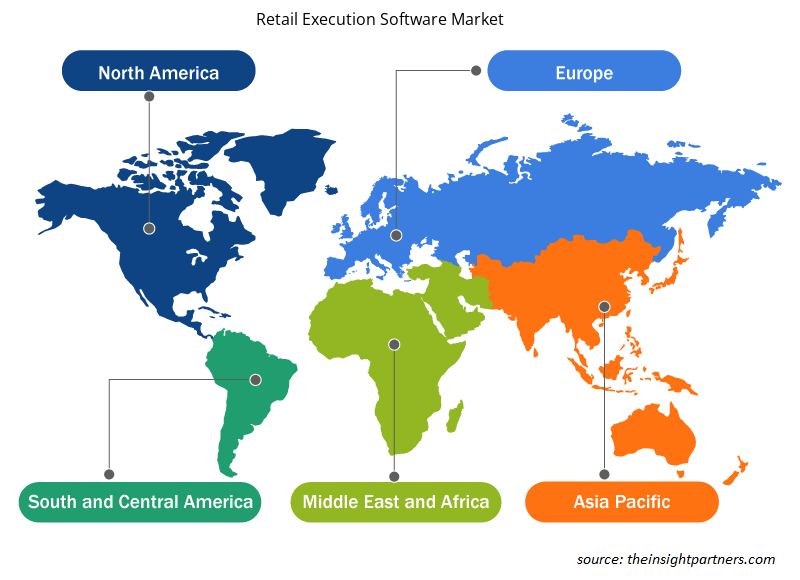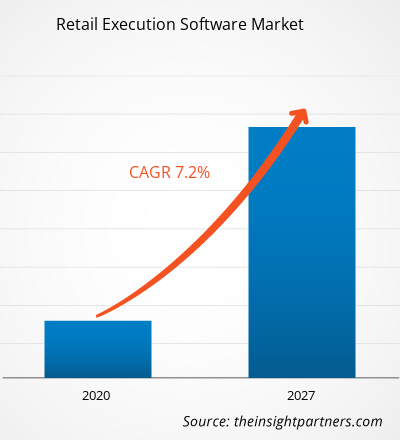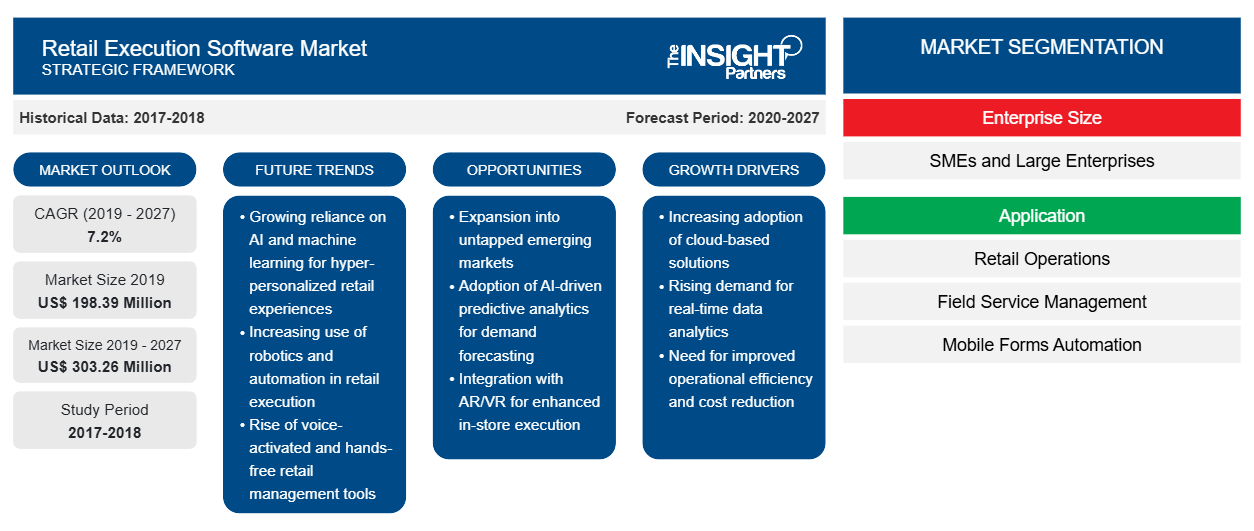小売実行ソフトウェア市場は、2019年に1億9,839万米ドルと評価され、2027年までに3億326万米ドルに達すると予測されています。また、2020年から2027年にかけて7.2%のCAGRで成長すると予想されています。
小売実行ソフトウェアの世界市場は、小売および電子商取引プラットフォームの選好の高まりと、小売実行ソフトウェアと決済ゲートウェイの統合の増加により、大幅な成長を遂げています。地域別では、北米が31.13%の収益シェアで市場をリードし、ヨーロッパとアジア太平洋地域がそれに続きます。急成長する経済の存在、自動化技術の採用の増加、インターネットの普及の増加、エンドユーザーによるソフトウェアの大規模な採用は、これらの地域で小売実行ソフトウェア市場の成長を促進すると予想される主な要因の一部です。アジア太平洋地域の小売実行ソフトウェア市場は、予測期間中に最高のCAGRで成長すると予想されています。小売業界での高度な技術の採用の増加は、小売実行ソフトウェアの採用率を促進します。企業は、業務運営を合理化するためにソフトウェアに投資します。アジア太平洋地域で小売および電子商取引の最も急成長している市場は、インドと中国です。これらの国の消費者は、インターネットの普及率の上昇によりオンラインショッピングに非常に傾倒しており、オンラインショッピングのトレンドは、この地域の小売および電子商取引のいくつかの分野を変革しています。したがって、これらの要因が、APAC における小売実行ソフトウェア市場の成長を推進しています。MEA や SAM などの他の発展途上地域も、先進技術の採用による経済のデジタル化に向けた政府の取り組みの増加により、着実なペースで成長すると予測されています。
要件に合わせてレポートをカスタマイズする
このレポートの一部、国レベルの分析、Excelデータパックなど、あらゆるレポートを無料でカスタマイズできます。また、スタートアップや大学向けのお得なオファーや割引もご利用いただけます。
-
このレポートの主要な市場動向を入手してください。この無料サンプルには、市場動向から見積もりや予測に至るまでのデータ分析が含まれます。
COVID-19パンデミックが小売実行ソフトウェア市場に与える影響
世界保健機関(WHO)の最新レポートによると、米国、スペイン、イタリア、フランス、ドイツ、英国、ロシア、トルコ、ブラジル、イラン、中国は、COVID-19の発生により最も深刻な影響を受けている国です。この危機は世界中の産業に悪影響を及ぼしています。世界経済は2020年に最悪の打撃を受け、2021年も続く可能性があります。この流行は、物流、小売、電子商取引などの一次産業に大きな混乱を引き起こしています。国際物流ビジネス業界の急激な衰退は、世界の小売実行ソフトウェア市場の成長を抑制しています。
小売実行ソフトウェア市場の洞察
決済ゲートウェイと小売実行ソフトウェアの統合の拡大
小売実行ソフトウェア市場の成長を促進
APAC では、ほとんどの消費者が商品の支払いにモバイルを使用しているため、オンライン決済が比較的普及しています。韓国、日本、シンガポール、オーストラリアなどの国では、モバイル デジタル購入にいくつかの一般的な電子決済オプションが使用されています。これらの国の決済ゲートウェイ企業は、技術開発の波に乗るために、さまざまな小売実行ソフトウェア プロバイダーに包括的な電子決済ソリューションを提供しています。さらに、市場の成長は、決済ゲートウェイ技術の進歩とモバイル ウォレットの使用の増加に起因しています。決済ゲートウェイ システムと小売実行ソフトウェアの統合の増加、オンライン ショッピングの増加、請求方法の進歩により、予測期間中に小売実行ソフトウェアの需要がさらに高まると予想されます。
企業規模に基づく市場分析
企業規模に基づいて、小売実行ソフトウェア市場は大企業と中小企業に分かれています。2019 年には、大企業セグメントが市場で大きなシェアを占めました。ただし、中小企業セグメントは予測期間中に大幅な CAGR を記録すると予想されます。
アプリケーションベースの市場分析
アプリケーションに基づいて、小売実行ソフトウェア市場は、小売業務、フィールドサービス管理、モバイルフォーム自動化、フィールドセールス、トレードプロモーション管理、従業員エンゲージメント、その他に分類されます。 2019 年には、小売業務セグメントが市場で大きなシェアを占めました。小売業務には、個人、サプライチェーン、店舗レイアウト、現金業務、実在庫、マスターデータ、プロモーション、価格設定の管理が含まれます。小売業務向けの小売実行ソフトウェアは、実店舗に現在の情報を活用し、ビジネスに役立つ方法で活用するためのツールを提供します。
企業は小売実行ソフトウェア市場での牽引力を獲得するために、新製品の開発に熱心に取り組んでいます。たとえば、Salesforce は Consumer Goods Cloud という新しい業界向け製品を発表しました。この製品により、消費財企業は小売実行機能の強化を通じて収益成長を促進し、ROI を向上させることができます。主要企業による開発のいくつかを以下に示します。
2020:StayinFront, Inc. の小売データ インサイト (RDI) は、リアルタイム分析のために Field Sales Solutions とのパートナーシップを拡大しました。StayinFront RDI のフィールド ビューと ROI ビューは、現場の営業チームに実用的なインサイトを提供します。これらのサービスは、店舗での有効性を促進し最大化することで、Field Sales Solutions のクライアントがより多くのことを実行し、より多くのことを知り、より多くのものを販売できるよう
にします。2018:Intelligence Retail は、IBM にアプローチして、主なサービスを強化し、顧客が主要な店舗監査指標をリアルタイムで追跡できるようにしました。組み込みの IBM Watson Analytics テクノロジーに基づく Intelligence Retail ソリューションの新しい分析モジュールは、棚の商品の在庫状況、棚のシェア、価格、プロモーションなどのビッグ データをリアルタイムで処理することで、小売監査の主要な指標を効果的に追跡できるように設計されています。
小売実行ソフトウェア市場の地域別分析
予測期間を通じて小売実行ソフトウェア市場に影響を与える地域的な傾向と要因は、Insight Partners のアナリストによって徹底的に説明されています。このセクションでは、北米、ヨーロッパ、アジア太平洋、中東およびアフリカ、南米および中米にわたる小売実行ソフトウェア市場のセグメントと地理についても説明します。

- 小売実行ソフトウェア市場の地域別データを入手
小売実行ソフトウェア市場レポートの範囲
| レポート属性 | 詳細 |
|---|---|
| 2019年の市場規模 | 1億9,839万米ドル |
| 2027年までの市場規模 | 3億326万米ドル |
| 世界のCAGR(2019年 - 2027年) | 7.2% |
| 履歴データ | 2017-2018 |
| 予測期間 | 2020-2027 |
| 対象セグメント |
企業規模別
|
| 対象地域と国 |
北米
|
| 市場リーダーと主要企業プロフィール |
|
小売実行ソフトウェア市場のプレーヤー密度: ビジネスダイナミクスへの影響を理解する
小売実行ソフトウェア市場は、消費者の嗜好の変化、技術の進歩、製品の利点に対する認識の高まりなどの要因により、エンドユーザーの需要が高まり、急速に成長しています。需要が高まるにつれて、企業は提供内容を拡大し、消費者のニーズを満たすために革新し、新たなトレンドを活用し、市場の成長をさらに促進しています。
市場プレーヤー密度とは、特定の市場または業界内で活動している企業または会社の分布を指します。これは、特定の市場スペースに、その規模または総市場価値と比較して、どれだけの競合相手 (市場プレーヤー) が存在するかを示します。
小売実行ソフトウェア市場で事業を展開している主要企業は次のとおりです。
- ビゾム(モビシーテクノロジーズプライベートリミテッド)
- EdgeCG(StayinFront株式会社)
- インテリジェンス リテール
- モビソフト
- POPプローブ
免責事項:上記の企業は、特定の順序でランク付けされていません。

- 小売実行ソフトウェア市場のトップキープレーヤーの概要を入手
企業規模別
- 大企業
- 中小企業
アプリケーション別
- 小売事業
- フィールドサービス管理
- モバイルフォーム自動化
- フィールドセールス
- トレードプロモーション管理
- 従業員エンゲージメント
- その他
地理別
-
北米
- 私たち
- カナダ
- メキシコ
-
ヨーロッパ
- フランス
- ドイツ
- イタリア
- 英国
- ロシア
- その他のヨーロッパ
-
アジア太平洋(APAC)
- 中国
- インド
- 韓国
- 日本
- オーストラリア
- その他のアジア太平洋地域
-
中東・アフリカ(MEA)
- 南アフリカ
- サウジアラビア
- アラブ首長国連邦
- MEAの残り
-
南アメリカ(SAM)
- ブラジル
- アルゼンチン
- SAMの残り
企業プロフィール
- ビゾム(モビシーテクノロジーズプライベートリミテッド)
- EdgeCG(株式会社ステイインフロント)
- インテリジェンス リテール
- モビソフト
- POPプローブ
- スプリングモバイルソリューションズ株式会社
- Trax Technology Solutions Pte Ltd.
- ヴァロムニア
- 勝つ
- カンターグループ
- 過去2年間の分析、基準年、CAGRによる予測(7年間)
- PEST分析とSWOT分析
- 市場規模価値/数量 - 世界、地域、国
- 業界と競争環境
- Excel データセット
最新レポート
関連レポート
お客様の声
購入理由
- 情報に基づいた意思決定
- 市場動向の理解
- 競合分析
- 顧客インサイト
- 市場予測
- リスク軽減
- 戦略計画
- 投資の正当性
- 新興市場の特定
- マーケティング戦略の強化
- 業務効率の向上
- 規制動向への対応























 無料サンプルを入手 - 小売実行ソフトウェア市場
無料サンプルを入手 - 小売実行ソフトウェア市場